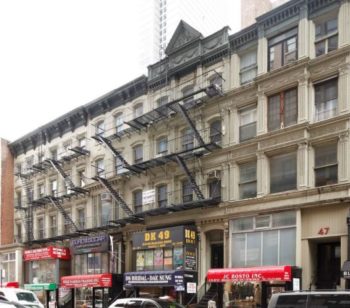
Nos. 47 – 55 West 28th Street were the home of many sheet music publishers in the 1890s and 1900s. Image Credit: NYC LPC
Proposed buildings were home to prominent sheet music publishers in the late 1800s and early 1900s. On March 12, 2019, the Landmarks Preservation Commission voted to add five buildings on West 28th Street between Broadway and Sixth Avenue to its calendar for consideration for landmark designation. The five buildings – 47 – 55 West 28th Street – represent a time when the street was known as “Tin Pan Alley” due to the noise of all of the piano music from various sheet music publishers located on the block.
Nos. 47-55 West 28th Street are Italiante row houses that feature bracketed cornices, fenestration patterns, and projecting stone lintels and sills. All five buildings have renovations to accommodate two-story retail storefronts but retain much of their historic detail above the storefronts. The buildings were all built during the 1850s, and all five buildings were the home of many sheet music publishers in the late 1800s and early 1900s.
The block saw a significant concentration of sheet music publishers between 1893 and 1910. At the time, the offices of music publishers were located near music halls, theaters and other venues in order to facilitate work with songwriters and musicians. With the City’s entertainment district moving northward, the publishers’ move to Tin Pan Alley was the first time music publishers were all located in the same area.
Music publisher M. Witmark & Sons was the first publisher to move to the block. M. Witmark & Sons was located at 51 West 28th Street from 1893 to 1897 and expanded to 49 West 28th Street in 1896. M. Witmark & Sons developed the successful marketing strategy of distributing “professional copies” of music to well-known singers for free, which was a strategy that other publishers in the area soon followed. Soon, more publishers moved to the street, with as many as 38 music publishers located on Tin Pan Alley at one given time in 1907.
The block rose to prominence during a time where sheet music was widely popular, purchased by the public to be used at home for entertainment. According to Landmarks researchers, sheet music sales peaked at two billion copies sold in 1910 as more Americans began to own record players, which was more accessible than piano training.
Tin Pan Alley also featured the first African-American owned and operated music publishing business in the United States. The concentration of music publishers offered many opportunities for African American and Eastern European Jewish songwriters.
The block was also the inspiration for London’s Tin Pan Alley on Denmark Street for most of the 20th century.
At the calendaring hearing, the commissioners thanked the 29th Street Block Association and the Historic Districts Council for their advocacy for these buildings.
Landmarks will hold a public hearing and vote on designation at a later date.
By: Veronica Rose (Veronica is the CityLaw Fellow and a New York Law School Graduate, Class of 2018.)

